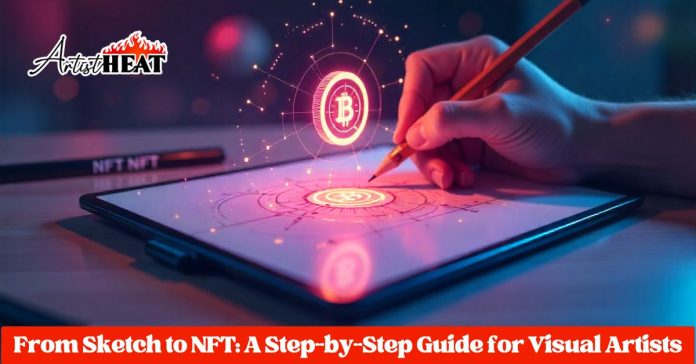The digital art revolution no longer knocks on our doors and windows and demands us to open the doors, it has already blown the doors and windows open itself and taken our couch. By converting their sketches into NFTs smart visual artists are already cashing in big bucks, even as traditional galleries even debate whether or not digital art even counts. The transition from sketch to NFT has become the modern artist’s equivalent of striking oil in their backyard, and honestly, it’s about time we all got in on this action.
Come on, seriously: the art world has always been a hard nut to crack. In previous centuries, artists were taking part in a fixed game and the most perfect art did not bring success that much as connections. But NFTs? They have reversed the role completely. All of a sudden your scrawl in that Zoom call when the meeting was not that interesting may end up paying your rent the following month.
Understanding the NFT Landscape in 2025
Things have changed in NFT space since those wild early days where folks were spending six figures on picture-based monkeys. The current market is highly advanced, more discriminating and literally, extremely up to date. The current from sketch to NFT journey requires actual artistic merit, not just hype and FOMO.
The days of gaining thousands by simply adding a rainbow filter to a selfie picture are gone. Contemporary NFT buyers are in search of authentic artistic vision, technical ability, and involving stories. This move really helps those who are serious at the visual arts and their voices were simply mired in the clamor of the fast money acquisition.
The big platforms are also changed. They now have superior artist tools along with reduced fees on OpenSea, Foundation, and SuperRare alongside more advanced algorithms in finding these items. Newer platforms such as Async Art and Manifold are exploring generative creative frontiers through programmable and interactive NFTs though.
Preparing Your Artwork for Digital Transformation
Optimization of the artwork into a digital medium is a process that must occur before you can consider minting. This is not simply a matter of scanning your drawing and taking the rest of the day off–the latter has been attempted by some people, with somewhat unsurprising inferior results.
High-resolution scanning is your starting point, but it’s just that—a starting point. Most successful from sketch to NFT transformations involve significant digital enhancement. Such creatives as Pak and XCOPY were not millionaires because they posted some half-baked pencil sketches. They realized that the digital medium needs digital thinking.
Such steps are colour correction, contrast and details enhancement. You can NOT use your grandmother flatbed scanner of 2003 here. Buy a good scanning device or have one done by a professional. The cost difference of the two scans of 50 dollars versus 200 dollars may result to thousands of dollars in ultimate sale.
Digital Enhancement Techniques That Actually Work
Here’s where things get interesting. The from sketch to NFT process isn’t just about preservation—it’s about transformation. With the digital devices, you can take in directions with the notion that were simply impossible when you were using traditional media.
Photoshop and Procreate are the more traditional tools, but you may not exclude such new applications as Clip Studio Paint or, surprisingly enough, Midjourney, which is AI-based software to diversify a concept. You should not transform your initial vision to any digital effects completely but give it an upgrade.
Most artists who have already had a successful presence in the NFT community make various copies of their art. Follow the way of Beeple, he produced 5,000 one-of-a-kind items in his world record-breaking series, called “Everydays.” You do not have to be that radical, but variations of your main idea may make you extremely popular on the market.
Animation is a whole different dimension. Non-animated NFTs are good, but an animated NFT is always priced higher. Simple animation- anything as minute as some gentle movement, colour changing- can make a good piece a great one.
Choosing the Right Blockchain and Marketplace
This decision can make or break your from sketch to NFT success story. Ethereum is the best there is, though the amount of gas required to make transactions may be stretched in the same number of time a teenager can destroy a pizza. Layer two solutions such as Polygon are cheaper and at times less transparent.
When it comes to up-and-coming artists, I would suggest getting on those platforms where the minting is gasless. Foundation and Async Art offer wonderful exposure at zero charges. As soon as you have acquired an audience, it is possible to move to more popular platforms.
Every market carries a culture and its customer base of collectors. SuperRare is more inclined towards proven digital artists whilst others like KnownOrigin are more open to novices. Study of countries in which artists of close styles to yours have achieved success.
Technology, put no eggs in the same digital basket. In 2025, it is essential to use cross-platform strategy. Post on several sites and address the audience in a different way. Going show-off on OpenSea may not work on Foundation.
Creating Compelling NFT Narratives
This is something that most guides will not tell you: it is the story, not art per se that is important. It is not only pixels the collectors are purchasing; it is stories, trends and creative paths. Your from sketch to NFT transformation needs a compelling backstory.
Write down the process of your creativity. Display the process of development starting with initial concept through to the finished digital work. Magpies will adore to see the touch of the hand of the artist as in the case where the work may exist in both the real and cyber worlds. Even the videos you capture during (with time-lapse) creating your works can be near equal in value to the actual piece.
Such artists as Refik Anadol have perfected this methodology by building complete artistic experiences around one NFT drop. You may not be in the position of inviting large museums but you can build immersive experiences by using such things as descriptions, documentation of the process, and interaction.
Marketing and Community Building
The “build it and they will come” approach died with dial-up internet. Successful from sketch to NFT transitions require serious marketing effort. The main arena of NFT promotion is Twitter, where various brands advertise them, but Instagram and TikTok are rapidly becoming the new frontiers.
You can never beat consistency with perfection. Being active in posting, interaction with other artists, and watching NFT Twitter discussions than spending your time trying randomly to be viral, will grow your audience better. Take people into the process, share failures, share your victories; speak in this space with authenticity.
Team work is the boss. Collaborate with fellow artists, join collective exhibitions and promote the art of your colleagues. NFT community, in its turn, rewards donators. Such artists as Mad Dog Jones became known to large audiences through regularly endorsing and advertising other creators.
Future-Proofing Your NFT Strategy
Looking toward 2025 and beyond, the from sketch to NFT landscape will continue evolving rapidly. NFTs based on utility are gaining popularity, i.e., objects that come with tangible additional benefits in addition to being a token of ownership. And think how you can give your art lasting value to collectors.
The use of AI tools will become a norm. AI will also have a creative use as Smart artists will take advantage to improve or complement their creative process and not to replace it. AI is an advanced, capable digital assistant that should help you dig through concepts quicker and more in-depth.
The integration of virtual and augmented reality is not a sci-fi anymore. Digital art with the possibility of being exhibited in virtual galleries or accessible with the help of AR filters will be of high value. It is the right time to begin experimenting with these technologies in order not only to keep up with the trend.
The Honest Truth About NFT Success
Let’s cut through the noise for a moment. The from sketch to NFT journey isn’t a guaranteed money printer. To each artist who seems to have a success story to tell, there are hundreds of artists who never sold a piece. The competition becomes more and more tough in the market and the standards of quality become higher.
But to those artists not afraid to take this seriously as not a get-rich-quick scheme but as a true form of art, the opportunities are enormous. It is all about looking at NFTs more as an addition to your artistic practice, rather than the getting away, per se.
The basics of success in this area are equivalent to those of other art markets: the good work, regularity of work produced, maintaining relationships with communities, having professional appearance. The system and tools may vary, yet the principles are the same.
The from sketch to NFT transformation represents more than just a new sales channel— it is a radical change of approach to the aspects of adult possession, the shares of art, and its pricing. Any artists capable of making that adjustment and continuing with their true voice and creativity will be in a good position to withstand whatever the next step in the fast changing digital art world holds for digital artists.
Your sketches never were more likely than they are to-day. The question isn’t whether you should explore the from sketch to NFT journey—it’s whether you can afford not to.

